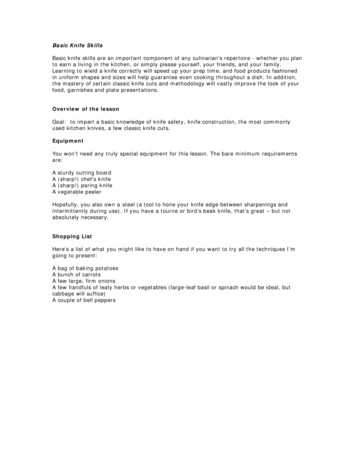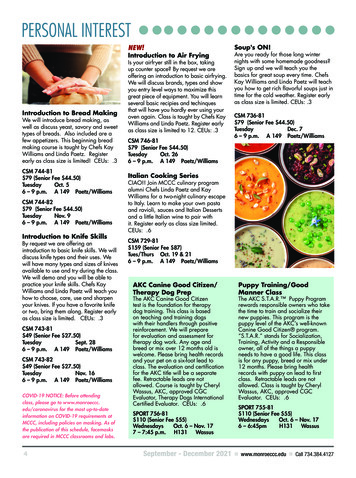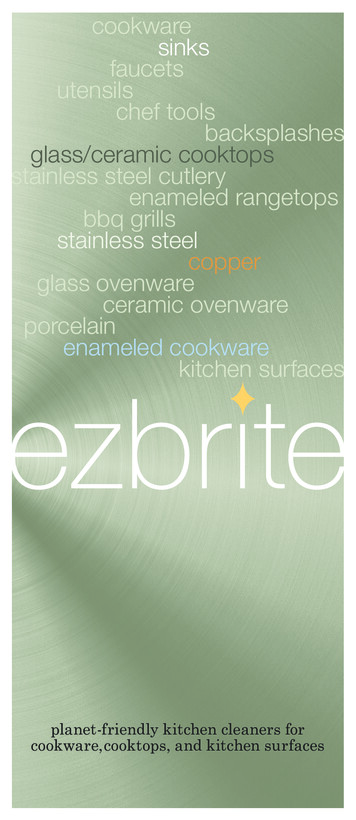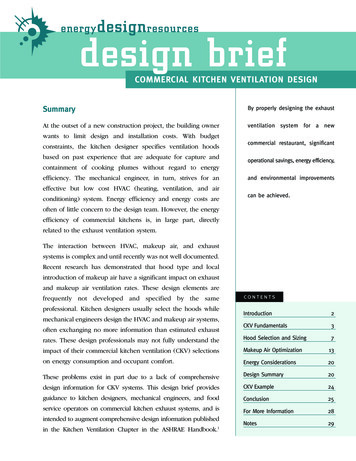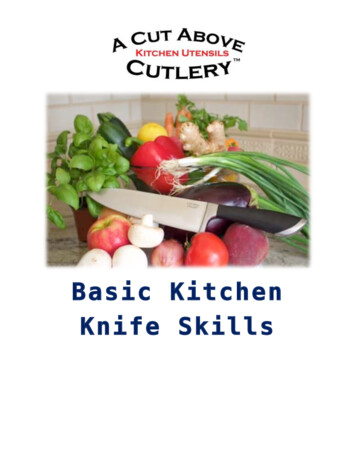
Transcription
Basic KitchenKnife Skills
Basic Kitchen Knife SkillsContentsIntroduction . 31. Holding The Knife . 42. The Guiding Hand . 83. Mincing . 104. Shredding . 115. Dice Cuts . 126. Diagonal & Bias Cuts . 137. Turning . 148. Julienne & Bâtonnet. 152
Basic Kitchen Knife SkillsIntroductionIf there is one knife that you simply can’t be without, it’s this one! The Chef’s Knife from A CutAbove Cutlery is an all‐purpose blade ideal for a wide variety of cutting tasks. The eight‐inchlength is perfect for slicing, dicing, and chopping small to medium‐sized fruits, vegetables andother foods. The wide blade keeps knuckles off the cutting board and is extra handy whentransferring cut food from board to pan.With its curved belly, the Chef’s Knife can be gently rocked through fresh herbs or spices toproduce a very fine mince.In the following sections, we’ll look at some suggestions on how to improve your knife skills.Let’s get started!3
Basic Kitchen Knife Skills1. Holding TheKnifeIt is important to be comfortable with your knife as you work. There are several different waysa knife can be held. The way you hold the knife will be determined in part by the way your knifeand your hand fit one another. The grip you choose also will be determined according to thetask at hand. Delicate cutting or shaping techniques will call for greater control, involvingfingertips more than the fist. Coarser chopping and cutting tasks require a firmer grip and moreleverage. Here are a few ways you can hold your Chef’s knife: Grip the handle with all four fingers and hold the thumb gently but firmly against theblade’s spine.4
Basic Kitchen Knife Skills Grip the handle with all four fingers and hold the thumb gently but firmly against theside of the blade.5
Basic Kitchen Knife Skills Grip the handle with three fingers, rest the index finger flat against the blade on oneside, and hold the thumb on the opposite side to give additional stability and control.6
Basic Kitchen Knife Skills Grip the handle overhand, with the knife held vertically – this grip is often used with aboning knife when butchering large cuts of meat. (Or when attacking a cantaloupe.)7
Basic Kitchen Knife Skills2. The Guiding HandYour grip on the knife is determined as much by your personal preference and comfort as it isby the cutting tasks at hand. The same is true for your guiding hand, the hand responsible forcontrolling the food you are cutting.Figure 1Figure 2Figure 3The guiding hand, the hand not holding the knife, is used to hold the object being cut. This isdone to prevent food from slipping as you cut it. It also makes it easier to control the size of thecut or slice you are making.One of the classic positions for the guiding hand is illustrated in Figure 1. The fingertips aretucked under slightly and hold the object, with the thumb held back from the fingertips. Theknife blade then rests against the knuckles, preventing the fingers from being cut.When you peel or trim foods, cut them into tournées, or flute them, you may find yourselfholding the food in the air, above the cutting surface. In that case, the guiding hand holds andturns the food against the blade to make the work more efficient as illustrated in Figure 2. Besure that the food, your hands, and your knife handle are very dry.Certain cutting techniques, such as butterflying meats or slicing a bagel in half, call for theguiding hand to be placed on top of the food to keep it from slipping, while the cut is made into8
Basic Kitchen Knife Skillsthe food parallel or at an angle to the work surface. Holding your hand flat on the upper surfaceof the food with a little pressure makes these cuts safe to perform. This is illustrated in Figure 3.The guiding hand is also used to hold a carving or kitchen fork when disjointing or carvingcooked meats and poultry. The tines of the fork can be laid flat on the surface of the food orinserted directly into the item to hold it in place as it is carved.9
Basic Kitchen Knife Skills3. MincingMincing is a very fine cut that is suitable for many vegetables and herbs. When mincing herbs,rinse and dry them thoroughly, and strip the leaves from the stems. Gather the leaves in a pile on a cutting board. Use your guiding hand to hold them in place and position the knife so that it can slicethrough the pile; coarsely chop. Once the herbs are coarsely chopped, use the fingertips of your guiding hand to hold thetip of the chef’s knife in contact with the cutting board. Keeping the tip of the blade against the cutting board, lower the knife firmly and rapidly,repeatedly cutting through the herbs. Continue cutting until the desired fineness isattained.10
Basic Kitchen Knife Skills4. ShreddingShredded or grated items can be coarse or fine, depending on the intended use. Foods can beshredded with a chef’s knife, a slicer, shredding tools and attachments, a mandoline or boxgrater. When cutting tight heads of greens, such as Belgian endive and head cabbage, cut thehead into halves, quarters, or smaller wedges and remove the core before cuttingshreds with your chef’s knife. The tip of the knife either remains in contact with the board as you cut or comes incontact with the board as you make a smooth downward slicing stroke. The blade’sedge rocks onto and off of the cutting surface with each stroke. To shred or grate larger quantities, use a box grater or a food processor fitted withgrating disks. An electric slicer can be used to shred cabbage and heads of lettuce.11
Basic Kitchen Knife Skills5. Dice CutsDicing is a cutting technique that produces a cube‐shaped product. Different preparationsrequire different sizes of dice ‐ fine (brunoise), small, medium, and large dice. The term brunoise is derived from the French verb, brunoir (to brown), and reflects thecommon practice of sautéing these finely diced vegetables. Trim and peel the vegetables as needed. Cut the slices to the thickness that you wish the finished dice to be. Stack the slices on top of one another and make even parallel cuts to the appropriatethickness. Gather the sticks together; using your guiding hand to hold them in place, and makecrosswise parallel cuts through the sticks. To produce a perfectly even and neat dice, these cuts should be the same thickness asthe initial slices.12
Basic Kitchen Knife Skills6. Diagonal &Bias CutsThis cut is often used to prepare vegetables for stir‐fry and other Asian‐style dishes because itexposes a greater surface area and shortens cooking time. Place the peeled or trimmed vegetable on the work surface. Hold the blade so that it is cutting through the food on an angle; the wider the angle,the more elongated the cut surface will be. Continue making parallel cuts, adjusting the angle of the blade so that all the pieces areapproximately the same size.13
Basic Kitchen Knife Skills7. TurningTurning vegetables (tourner in French) requires a series of cuts that simultaneously trim andshape the vegetable. The shape may be similar to a barrel or a football. This is one of the mostdemanding, time‐consuming, and exacting cuts. Peel the vegetable if desired or necessary. If the trimmings can be used with the peelstill intact, or if there is no appropriate use for the trimmings, you do not need to peelthe vegetable. Cut the vegetable into pieces of manageable size. Hold the vegetable in your guiding hand. Using a paring knife or tourné knife, carve thepieces into barrel or football shapes. To produce classic tournés, you should cut the vegetable so that it has seven even sidesor faces. The faces should be smooth, evenly spaced, and tapered so that both ends arenarrower than the center.14
Basic Kitchen Knife Skills8. Julienne &BâtonnetJulienne and bâtonnet are long, rectangular cuts. Related cuts are the standard pommes fritesand pommes pont neuf cuts (fancy names for French fries) and the allumette (or matchstick)cut. The difference between these cuts is the final size. Julienne cuts are 1/8 inch in thickness and 1‐2 inches long. Bâtonnet cuts are ¼ inch in thickness and 2‐2 ½ inches long.These dimensions may be modified slightly to suit a specific need. The key point to keep inmind is that each cut should be nearly identical in dimension to all others for even cooking andthe best appearance. Trim and square off the vegetable by cutting a slice to make four straight sides. Cut bothends to even the block off. These initial slices make it easier to produce even cuts. Thetrimmings can be used for stocks, soups, purées, or any preparation where shape is notimportant.15
Basic Kitchen Knife Skills Slice the vegetable lengthwise, using parallel cuts of the desired thickness. Stack the slices, aligning the edges, and make parallel cuts of the same thicknessthrough the stack.We hope you enjoyed these tips!16
Basic Kitchen Knife Skills 4 1. Holding The Knife It is important to be comfortable with your knife as you work. There are several different ways a knife can be held. The way you hold the knife will be determined in

